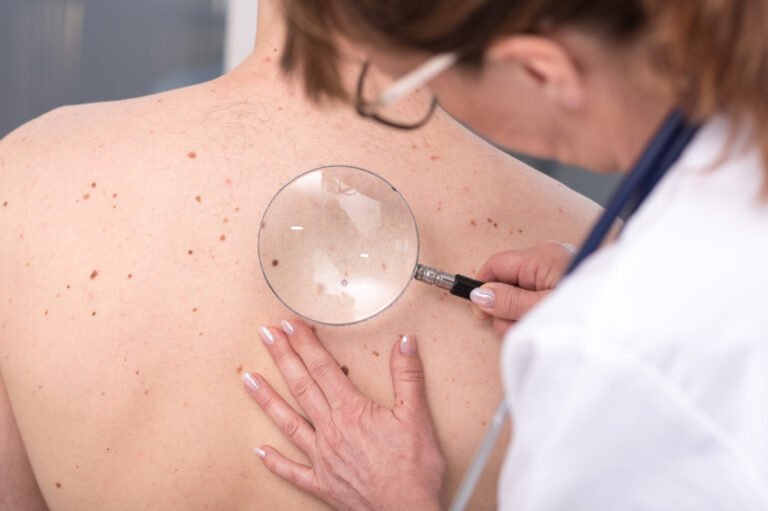

Overview
Skin cancer, characterized by the uncontrolled proliferation of skin cells, predominantly occurs on skin that is regularly exposed to the sun. However, this prevalent cancer type can also manifest on parts of the skin that are not typically sun-exposed.
The primary forms of skin cancer include basal cell carcinoma, squamous cell carcinoma, and melanoma.
To decrease the risk of skin cancer, it’s advisable to minimize or avoid exposure to ultraviolet (UV) rays. Regular skin checks for unusual changes can aid in the early detection of skin cancer, significantly improving the likelihood of successful treatment.

Symptoms Localization of Skin Cancer Development




Skin cancer mainly forms on sun-exposed areas such as the scalp, face, lips, ears, neck, chest, arms, hands, and in women, the legs. It can also develop in less exposed areas like the palms, under fingernails or toenails, and the genital region.
Skin cancer can affect individuals of every skin tone, including those with darker complexions. In darker-skinned individuals, melanoma is more likely to appear in typically sun-shielded areas like the palms and soles.
Basal Cell Carcinoma Characteristics This cancer type often develops in areas exposed to the sun, such as the neck and face. It may present as:
- A pearly or waxy bump
- A flat lesion resembling a scar, in flesh color or brown
- A recurring sore that bleeds or scabs
Squamous Cell Carcinoma Characteristics Squamous cell carcinoma frequently arises in sun-exposed regions like the face, ears, and hands. In darker-skinned individuals, it may occur in less exposed areas. This cancer may manifest as:
- A firm, red nodule
- A flat lesion with a scaly, crusted surface

Melanoma Characteristics Melanoma can arise on any part of the body, either within normal skin or from an existing mole that turns cancerous. It is commonly found on the face or trunk in men and on the lower legs in women. It can also develop on non-sun-exposed skin.
Melanoma can affect individuals of any skin tone. For those with darker skin, melanoma often appears on the palms or soles, or under nails.
Melanoma signs include:
- A large brownish spot with darker speckles
- A mole that changes in color, size, or feel, or that bleeds
- A lesion with irregular borders, with varied colors
- A painful lesion that itches or burns
- Dark lesions on less exposed body parts or mucous membranes
Signs of Less Common Skin Cancers Other rarer skin cancers include:
- Kaposi sarcoma, which develops from the blood vessels and appears as red or purple patches, predominantly in immunocompromised individuals.
- Merkel cell carcinoma, which forms shiny nodules, usually found on the head, neck, or trunk.
- Sebaceous gland carcinoma, an aggressive cancer originating from the oil glands, frequently misidentified as other eyelid issues.
When to Consult a Doctor It’s important to consult a doctor if you observe any concerning skin changes. Not all skin changes indicate cancer, but a professional evaluation is crucial.
Causes

Skin cancer arises from mutations in the DNA of skin cells, leading to uncontrolled growth and mass formation.
Cell Types Involved in Skin Cancer Skin cancer starts in the epidermis, the protective outer skin layer, which continuously sheds cells. The epidermis houses:
- Squamous cells, just below the surface, serving as the inner lining.
- Basal cells, which produce new skin cells, situated under the squamous cells.
- Melanocytes, located deeper in the epidermis, produce melanin, which colors the skin and protects it from sun damage.
The type of skin cancer and treatment options depend on where the cancer begins.
Ultraviolet Light and Other Potential Causes Most skin DNA damage stems from UV radiation in sunlight and tanning beds. However, cancers on non-sun-exposed skin suggest other contributing factors, like exposure to toxins or having a compromised immune system.

Risk Factors Risk factors for skin cancer include:
- Fair skin, which has less melanin and less natural protection from UV radiation.
- A history of sunburns, which significantly increases the risk.
- Excessive sun exposure or tanning.
- Living in sunny or high-altitude climates, where UV exposure is greater.
- Numerous or abnormal moles.
- Precancerous skin lesions like actinic keratoses.
- A family or personal history of skin cancer.
- A weakened immune system or exposure to radiation or certain chemicals.

Prevention
Most skin cancers are preventable. Prevention tips include:
- Avoiding midday sun, when UV rays are strongest.
- Wearing sunscreen year-round with an SPF of at least 30, applying generously and reapplying regularly.
- Wearing protective clothing and sunglasses that block UVA and UVB rays.
- Avoiding tanning beds and being cautious of sun-sensitizing medications.
- Regularly checking your skin for new growths or changes and consulting a doctor for any concerns.
